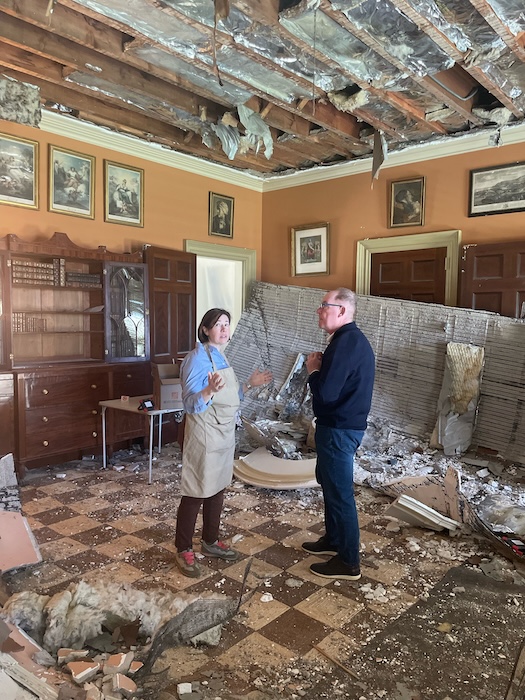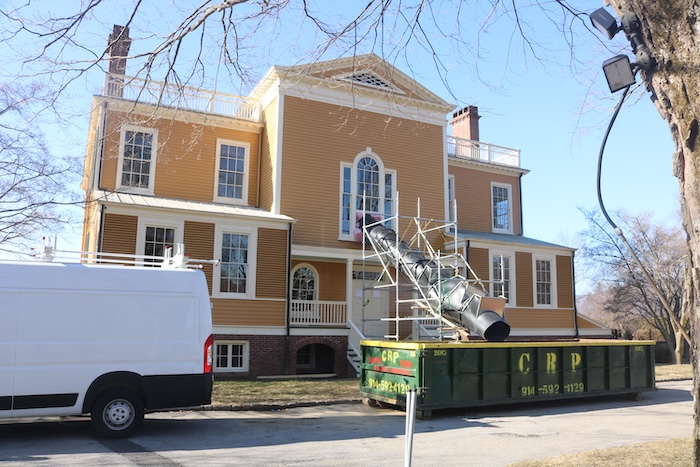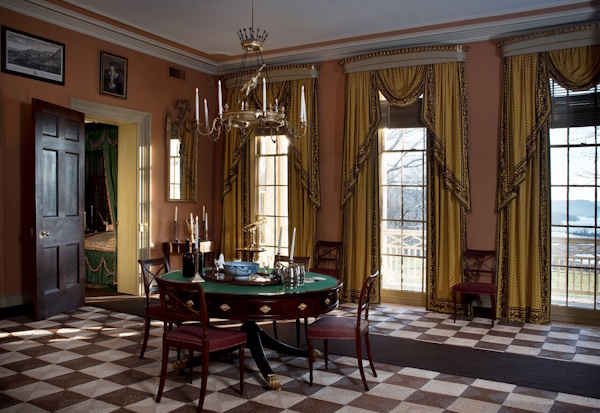Boscobel launches $2 million-plus restoration
Jennifer Carlquist will never forget the evening of April 16, when she learned a ceiling in the historic mansion at Boscobel House and Gardens had collapsed.
Carlquist, its executive director and curator, has been in the museum business for 30 years, including the past 10 at Boscobel. She is used to making nighttime runs from her home to deal with routine problems such as false security alarms.
This call was different. “It was beyond my worst nightmare,” she said. “I could never have imagined what I saw.”
The collapse left the floor covered with plaster, broken period furniture, damaged antiques and debris. An investigation revealed a 1950s reconstruction flaw: The ceilings were made of concrete and, after more than 65 years (the early 19th-century mansion was moved from Montrose to Philipstown in 1955 to escape the wrecking ball), the shank nails could no longer handle the weight.
The force of the collapse was so great it impacted rooms throughout the mansion. Nineteen of its 24 ceilings now need replacement, Carlquist said.

And it could have been worse. “Hours before, we had a school group in that room,” Carlquist said. “And their teacher, who used to work at Boscobel, was pregnant.”
Carlquist recalled the outpouring of support that followed. M&T Bank, Antipodean Books, Yannitelli Wine and Spirits and Foodtown provided boxes, the Appalachian Market lent a dumpster, the Desmond-Fish library shared air scrubbers and the Greater Hudson Heritage Network arranged for vacuums, supplies and volunteers.
Resources were also made available by the Smithsonian Cultural Rescue Initiative, Metropolitan Museum of Art’s American Wing, Greenwich Historical Society, Stair Galleries and Caramoor, she said.
Reconstruction is now well underway. Carlquist estimates Phase 1 will cost about $2 million, but “that doesn’t include replacing carpets, window treatments or wallpapers that were ruined. That’s Phase 2,” she said.

A public fundraising campaign has begun and the National Trust for Historic Preservation has been approached for money. Representatives from the Department of Parks, Recreation & Historic Preservation will visit soon to advise about state grants, Carlquist said.
“We have a federal grant from the National Endowment for the Arts for an exhibition that’s supposed to open this fall,” she said. “We’re on pins and needles, hoping there isn’t a disruption to funding” because of Trump administration cuts.
Carlquist said the restoration is a chance to rethink the mansion, making it more accessible in part by removing some of the red ropes. For example, a second-floor room once served as living quarters for Sarah Wilkinson, an enslaved woman known as “Sill.” Removing ropes there would allow visitors to enjoy views overlooking the expansive gardens.

The Boscobel mansion was built by States Dyckman, a Loyalist who returned to the U.S. after fleeing during the America Revolution. He began construction in Montrose, 15 miles south, in 1806 but died that same year. Two years later his widow, Elizabeth, completed the Federal-style house, which was inspired by the symmetry of ancient Greek and Roman architecture.
By the early 20th century, the home was in disrepair. In 1955, it was sold at auction for $35 (about $400 today). Just before it was to be razed, historian Benjamin West Frazier purchased the house for $10,000 ($118,000), had it dismantled and stored the pieces. Lila Acheson Wallace, a philanthropist who had co-founded Reader’s Digest, financed the reconstruction in Philipstown overlooking the Hudson River, and the house opened for tours in 1961.
Boscobel is located at 1601 Route 9D. The mansion is closed but the grounds are open Saturdays from 9 a.m. to 2 p.m. Admission is $14 ($7 for ages 4 to 18). Sunday will be added by April 6, Friday by April 25 and Monday by Memorial Day. Some exhibits from the house have been moved to the Visitor Center.

